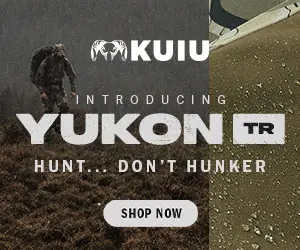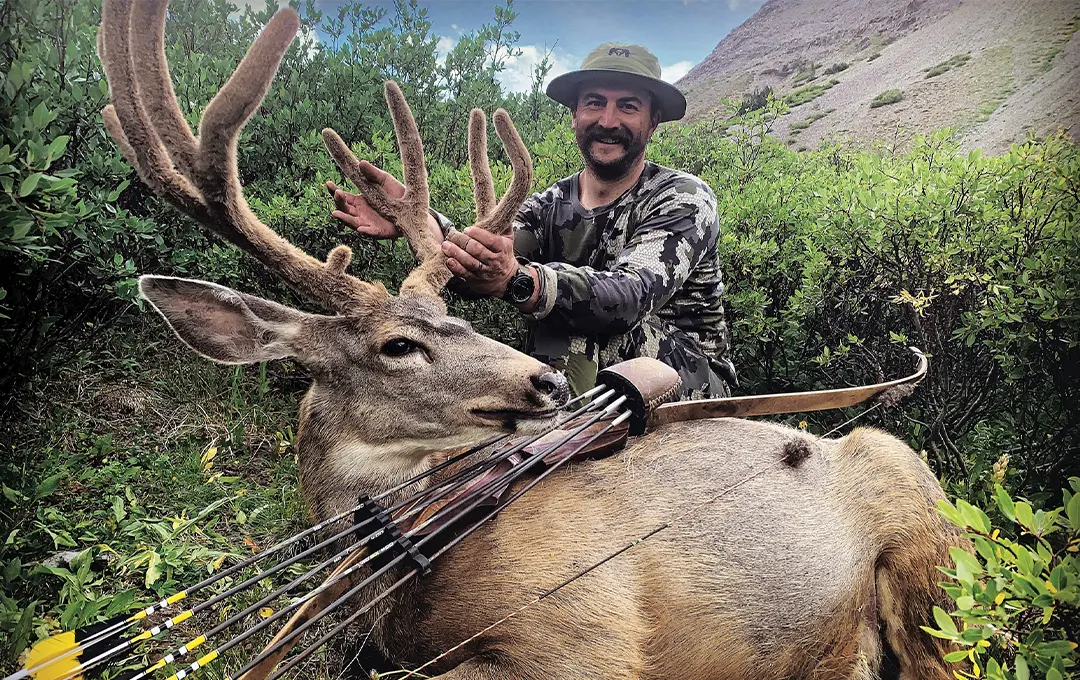
NOTICE: Certain links on this post may earn a commission for Western Hunter Magazine from Amazon or our other affiliate partners when you make a purchase. Thank you for your support.
Traditional Triumph
A gamble on a non-resident tag leads to a breakthrough for a patient stick-bow hunter.
I was blessed to grow up the son of a hunter in northern California. From a young age, I hunted blacktail deer in the steep, brushy, and heavily timbered forests that blacktail call home. I started archery hunting at 13 and eventually found some success with my compound. By 2017, I was ready for a new challenge. Fred Bear, Larry D Jones, South Cox, and my grandfather were my hunting idols, and they all shot stick bows; I was ready to make the switch. I bought an inexpensive recurve in January of that year and started shooting. I even took some lessons. I quickly discovered that despite shooting a compound for over 15 years, I had a lot to learn.
I relished the new challenge and was excited to shoot every day, something that had long since faded with the compound. I committed to only hunting with the recurve that season, and to practicing every day. To up the ante, I ordered a custom bow from South Cox at Stalker Stick-Bows; the money on the line kept me motivated to become lethal with the stick. I shot tens of thousands of arrows prior to the ‘17 hunting season, and when my first opportunity presented itself, it paid off. One arrow from the recurve zipped through my biggest blacktail to date.
Pushing Boundaries
Much of my early hunting was based out of a big deer camp. A travel trailer, meat pole, and a full ice chest was home base. We utilized stands, drives, and even the occasional road hunt to find bucks. As I grew older I found myself wanting to push further from roads, and eventually started backpack hunting. Of course, there was a learning curve; blisters, a pack overloaded with things I didn’t need, and plenty of bow hikes were endured before I punched any tags in the backcountry. Despite many failed attempts and lessons learned the hard way, I found that I enjoyed these experiences so much more, and when I finally found success, the culmination of hard work with a buck on my back was incredibly rewarding.
I hold blacktail deer in high regard, but I’ve always been infatuated with mule deer. For as long as I can remember I’ve wanted to hunt velvet mule deer in their high country summer range. Hunting mule deer above treeline is the spot-and-stalk hunter’s dream, and the thought that muleys often bed somewhere other than the thickest cover around (as Blacktail often do) has always seemed inviting. In early 2019, I set a plan in motion to head to Colorado to do just that.
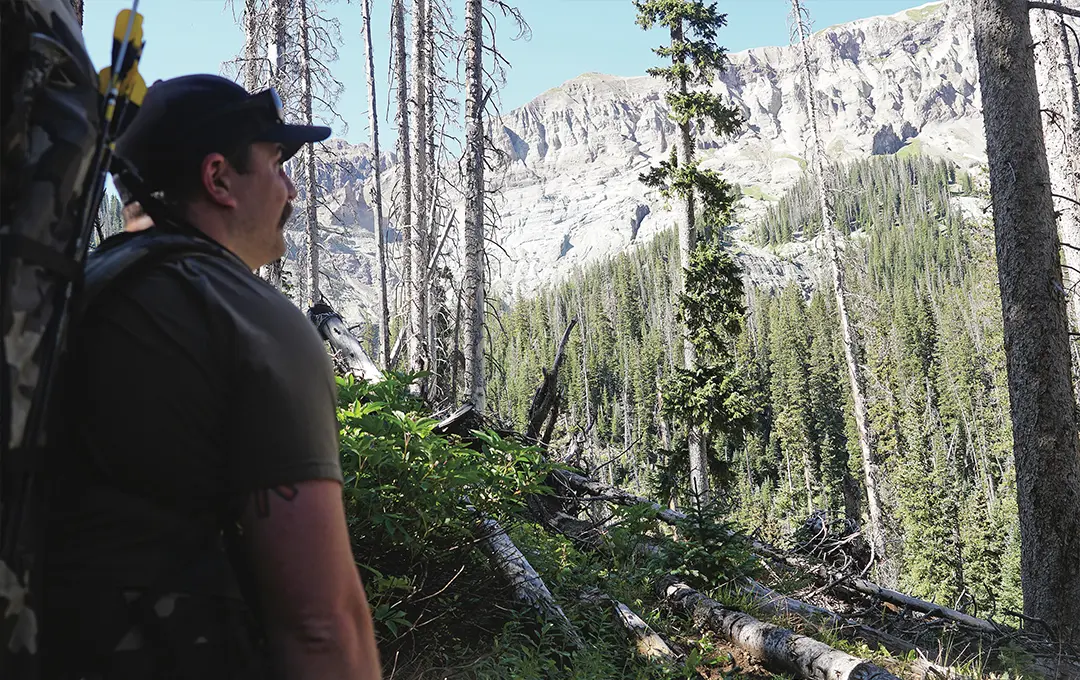
The prospect of finding an out-of-state unit to hunt can be extremely daunting, especially without the opportunity for boots-on-the-ground scouting. Throw in the cost of travel and a non-resident license, and the pressure is on to choose the right spot to get a return on your investment. I decided to use as many resources as possible to find the right spot for my first high country archery muley hunt, knowing that despite my effort, nothing was guaranteed. I pored over maps, called biologists and wildlife officers, and studied records of everything from herd dynamics to rainfall. I finally landed on a unit and sent in my application. When the draw results were posted and I drew the tag, I was both excited and nervous.
Lay of the Land
I devised plans A-E and continued to study maps and digital imagery daily. I wasn’t able to scout the area in person, but by the time I loaded the truck to head to Colorado, I felt like I knew the area pretty well. Originally, I planned for this to be a solo hunt, but when my good friend Jonny offered to tag along to help, I welcomed the idea of having company (and someone to help pack meat). In the meantime, I had work to do. I knew this hunt would be physically demanding, and my cardio needed work.
I upped my shooting regimen. I spent a lot of time shooting off of my roof, much to the dismay of my wife and neighbors, in order to simulate the steep angles I anticipated above the treeline. I tested and tinkered with broadhead and arrow setups, prepared my gear, and loaded and unloaded my pack incessantly. Finally, the day had arrived and it was time to go. Still nervous but mostly excited, we loaded the truck and started the long drive to Colorado.
We arrived at the plan A trailhead late Thursday night after driving straight through, and quickly made camp and got to sleep. I live approximately 600 feet above sea level and expected to climb to as high as 13000 feet on this trip. I knew the altitude would take some getting used to, so it was crucial to take some time to acclimate. I hoped that spending the first night at 10500’ at the trailhead would help, and maybe it did, but not enough.
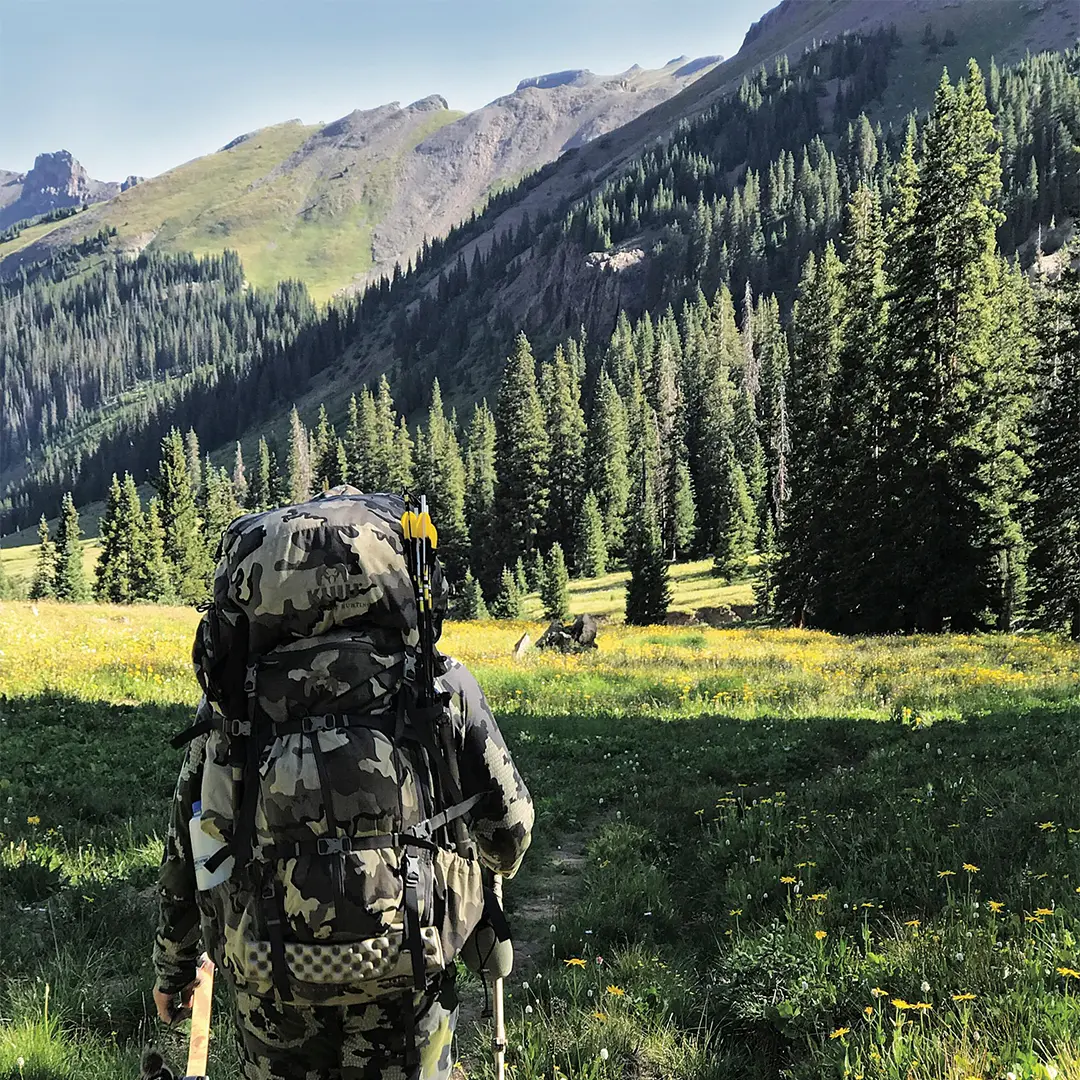
We woke early Friday morning and started our ascent into the high country. Plan A was to camp in a high saddle that provided views of two basins. We had seven miles and 2500 vertical feet to go. I felt good on the way in and made camp with ample time to start glassing. We met a few other hunters on our way in but seemed to have plan A to ourselves. I spotted a few smaller bucks that evening, but was already worried about finding what I hoped for, and bummed about the competition in the area. It was a rough night of sleep. I was nowhere near acclimated and woke up throughout the night feeling ill and dehydrated despite drinking plenty of water.
When the alarm went off, I forced myself out of the sleeping bag to put on my boots and warm up breakfast and coffee. I managed only three bites and puked. Jonny was still in his tent with a headache. I managed a couple of hours of glassing and even turned up a few decent bucks, but looking through the glass only seemed to make things worse. I crawled back in my tent by 9:00 AM and went to sleep. I woke up feeling stupid; I had worked and waited all year for this and I’m napping? I knew I was not going to quit, but I also knew we needed to drop elevation a bit, so we packed up and backtracked to 11000 ft and made camp 2.
Escaping the Crowd
I glassed that evening and the next morning and quickly decided it was time for plan B. I spotted a few good bucks, but it was obvious the other hunters (who were great guys) were already onto them, so on Sunday we decided to hike back to the truck and drive to another trailhead. This might seem crazy, but I have made the mistake of being married to plan A in the past and paid for it. I set a goal to be willing to move on this trip, so it was time to go.
When we arrived at trailhead B, I hadn’t told Jonny how far camp was. He was already starting to question what he had gotten into so I lied and said “it’s not much further than the last one.” After 10 miles of hiking, I told him we were there. He was relieved, and so was I. We had covered a lot of miles in the last two days and were spent. We set camp and I had an hour to glass before dark. I didn’t see much but had high hopes for the morning. This camp was different; we were lower in elevation, about 11500 ft. and closer to a water source, but further from the basin that I wanted to hunt. In fact, we were directly below it.
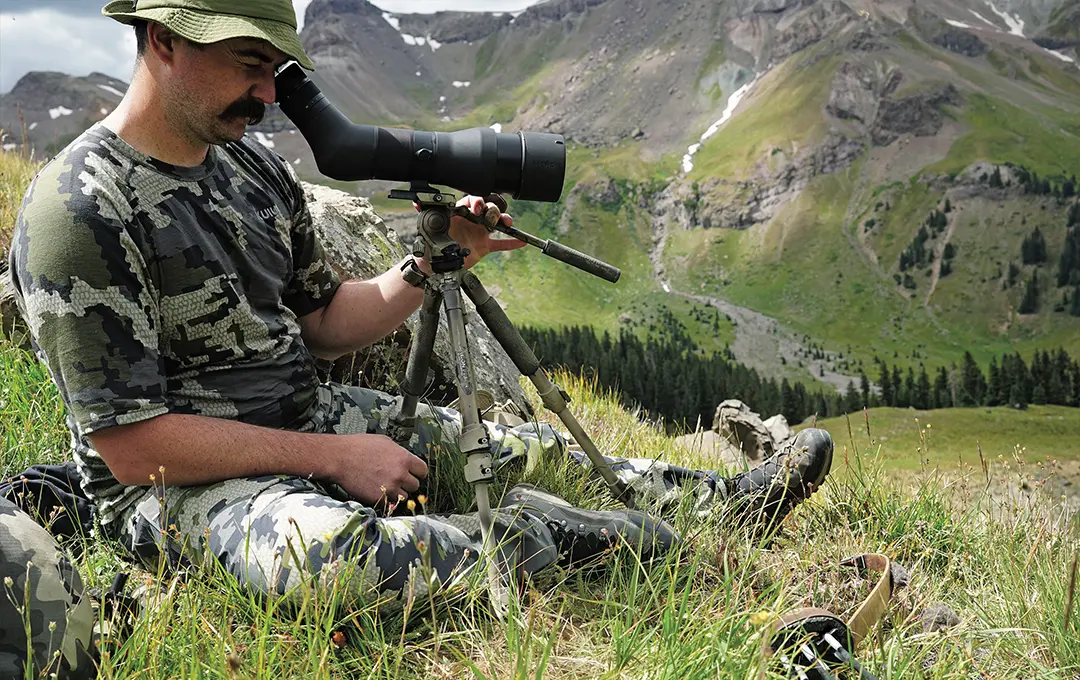
In the morning, I climbed what seemed to be straight up out of camp to reach the hanging basin above, and rode a ridgeline to a decent vantage. Jonny’s bum knee kept him in camp for the day, but I didn’t mind the solitude. I settled my tripod and attached my binos, and within seconds I had a good buck spotted. A pretty 4-point with an inline, he was exactly what I had hoped to find, and I watched him feed for what seemed like hours. He had a smaller buck with him, but there didn’t appear to be a lot of other deer to contend with. I sat atop a sheer cliff, surrounded by rockslides and scree; a great spot to glass from, but not a valid approach for a stalk. The buck fed through the willows, up the drainage, and toward the cliff wall to my left. He was about 200 yards out and soon the topography blocked my view of him.
I moved up the ridge hoping to get another angle. I saw him again briefly, but the rock outcropping below me obscured my view. I waited, expecting to see him come out further to my left, but after half an hour he hadn’t. I knew there was nowhere he could go that I couldn’t see him, so I assumed he had bedded under the rocks. By now it was late morning, and the thermals were blowing uphill in my favor, but there was nothing but steep scree slides and cliffs between us. There was no way I could get to him undetected, or safely for that matter.
Espionage
I studied the map and found a way into the drainage further up the ridge; a small saddle that would allow me to get close, and a finger ridge that would at least put me within view of his suspected bed. I dropped in and found the finger ridge, sure to stay off the backside and out of sight, and worked my way down to its point. Boots off, I carefully crept on my stomach and peered over the rise, freezing immediately when I saw antler tips. I was still above him, but now a small wide open drainage lay between us, and he was still 70 yards away. Too far for the stick bow, but perhaps he would get up and feed my way?
The smaller buck was bedded beside him. It was still early and perhaps they would feed again or change beds. Either way, I was stuck and decided my best play was to wait it out. Hours passed. My Nalgene was running low on water, and I was exposed to the August sun, which turned to clouds, then to rain, and then back to sun again. My merino shirt was soaked and I went from sweating to shivering, but the buck didn’t move.
I stayed in the same position for over six hours. Finally, the bucks started to stir. It was afternoon now, and I knew they would be getting up soon. I wiggled my toes to try and wake them up, arrow knocked, anticipating an opportunity. Then my heart sank as the bucks got up and fed directly away from me, down the basin toward where I had seen them at first light. Long out of water, I was parched and tired from exposure and began my long hike back to camp. A storm was rolling in and I didn’t want to get caught up in it on a knife ridge at 12000 ft.
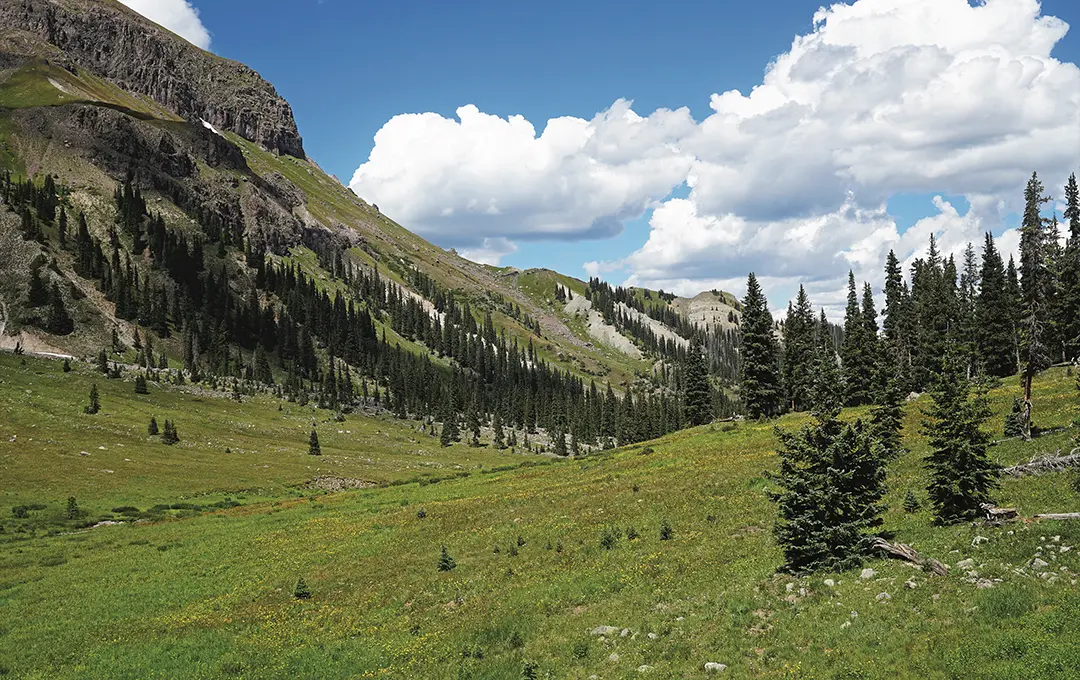
I got back to camp right at dark, and the rain was starting to fall. I was worried that the storm may ruin my chances the next day, and I only had two more full days to hunt. I told Jonny about the day's events and my concern about the storm. I even considered packing up and heading home early; a cheeseburger sounded damn good, the storm was going to screw up the deer anyway. It took a lot of self talk to put the thought of quitting to rest, but I managed and made the hellish climb the next morning.
I was sore and tired but surprisingly energized by the thought of getting another opportunity at the buck. I realized that my doubt and notions of quitting were directly related to my insecurity. What if you can’t get close enough? Can you even kill a deer with this stick? Why go through all this again? I told that guy to shut up and just kept hiking, and within minutes of daylight, I spotted my buck again, still with his little buddy.
The bucks were following the same path from the day prior. It didn’t take long for me to determine that they were heading for the same bed. This time, I had the benefit of knowing exactly where they were going. While watching the day before, I had hours to study the terrain and their behavior. The bucks were bedded below an eight-foot cliff with a commanding view of everything below. Above was a 30-yard patch of green grass, which seemed to be the only green grass on the mountainside. Above that was an extremely steep scree slide. Living on the scree were tons of pikas.
Valuable Intel
I watched them scurry across the scree, sending pebbles and rocks tumbling down below, so much so that the bucks seemed used to it. Numerous times I watched small slides of rocks trickle near the bucks, and they never showed much care. If I could keep the noise to a minimum, they might not suspect anything. I knew that he would stay there all day as this wasn’t just his “morning bed.” But most importantly, I planned a manageable approach that would put me above him without raising alarm.
I waited for the bucks to walk out of sight below my glassing point and disappear directly under the patch of green grass. When they didn’t emerge on the left side, I knew they had bedded, but wanted to give them some more time to settle. “Don’t rush it.” I decided to eat some food from my pack and give it a half-hour or so as it would likely be a while before I got another chance to eat. I planned on ditching my pack for the final approach. Once I decided the time was right, I located the chute the day before. My plan was to drop 200 vertical feet down the scree chute, then carefully sidehill to reach the green grass above their bed. I knew I would make more noise than a pika, and wanted to do it as far from the bucks as possible.
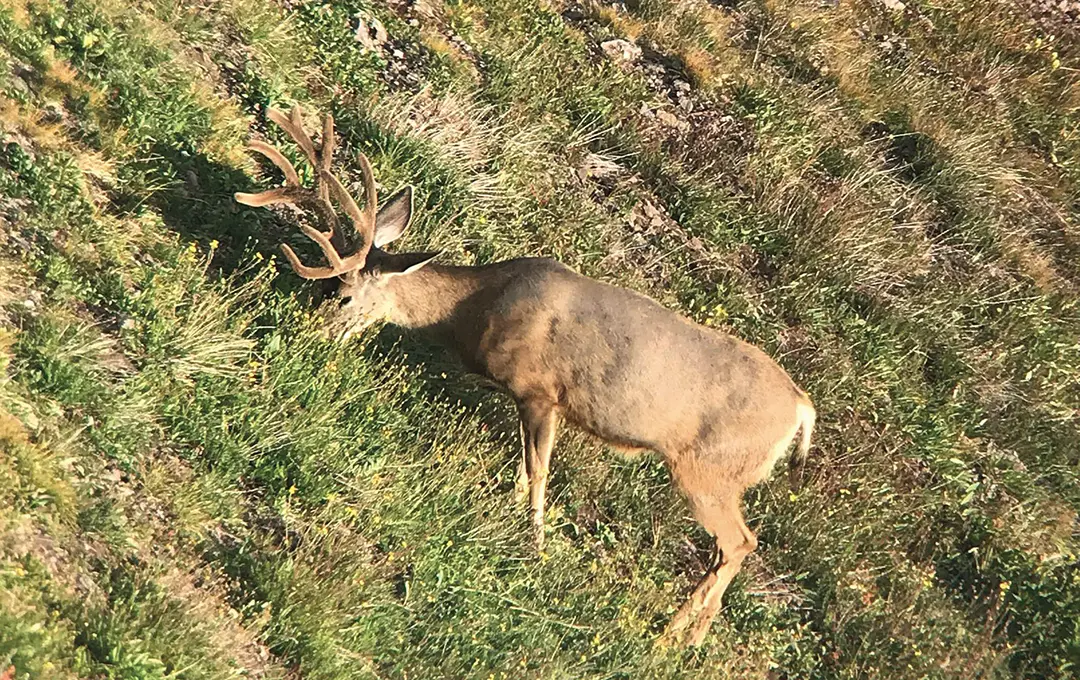
I kept my boots and pack on for this part, and tried my best to keep my feet while descending the avalanche chute of tumbling rock, but stressfully found myself sliding quite a bit. I managed to avoid causing big slides and hadn’t seen any deer blowing out of the basin. After reaching my landmark for the right elevation, I walked sidehill toward the grass, carefully placing each step and praying for the scree to hold. After what seemed like hours, I reached the top of the strip of grass and sat down. I quietly took off my pack and boots and nocked an arrow. The wind was blowing steadily in my face, and I had 30 yards of steep grassy slope left to navigate.
Getting Personal
Because the slope was so steep and my socks were slick on the grass, I decided to sit down with my bow in my lap and inch myself downhill with both hands on the ground. This is what Larry D would call the “4 point stalk,” with 4 points of contact with the ground. The sun was at my back, and I was careful not to cast my shadow where the bucks could see it. When I neared the edge, I crawled on my hands and knees to peer over the edge.
A mere eight feet straight down off the ledge, the 4-point with the inline was bedded, his head to my left. His legs were stretched out in front of him and his vitals exposed. I crept back, addressed the string, and inched forward, keeping an eye on my shadow. Crouched down, I could see the buck’s legs below me, my shadow close to the edge, but still out of his sight. “Pick a spot,” I thought to myself, trying to calm my nerves. I drew and leaned forward, exposing the rest of the buck, settled, and let an arrow go. “Thump.” My arrow stuck in the dirt between the buck’s legs. I shot high! He was only eight feet away and straight down, and I failed to compensate enough for the angle! I didn’t have time to think, only to react.
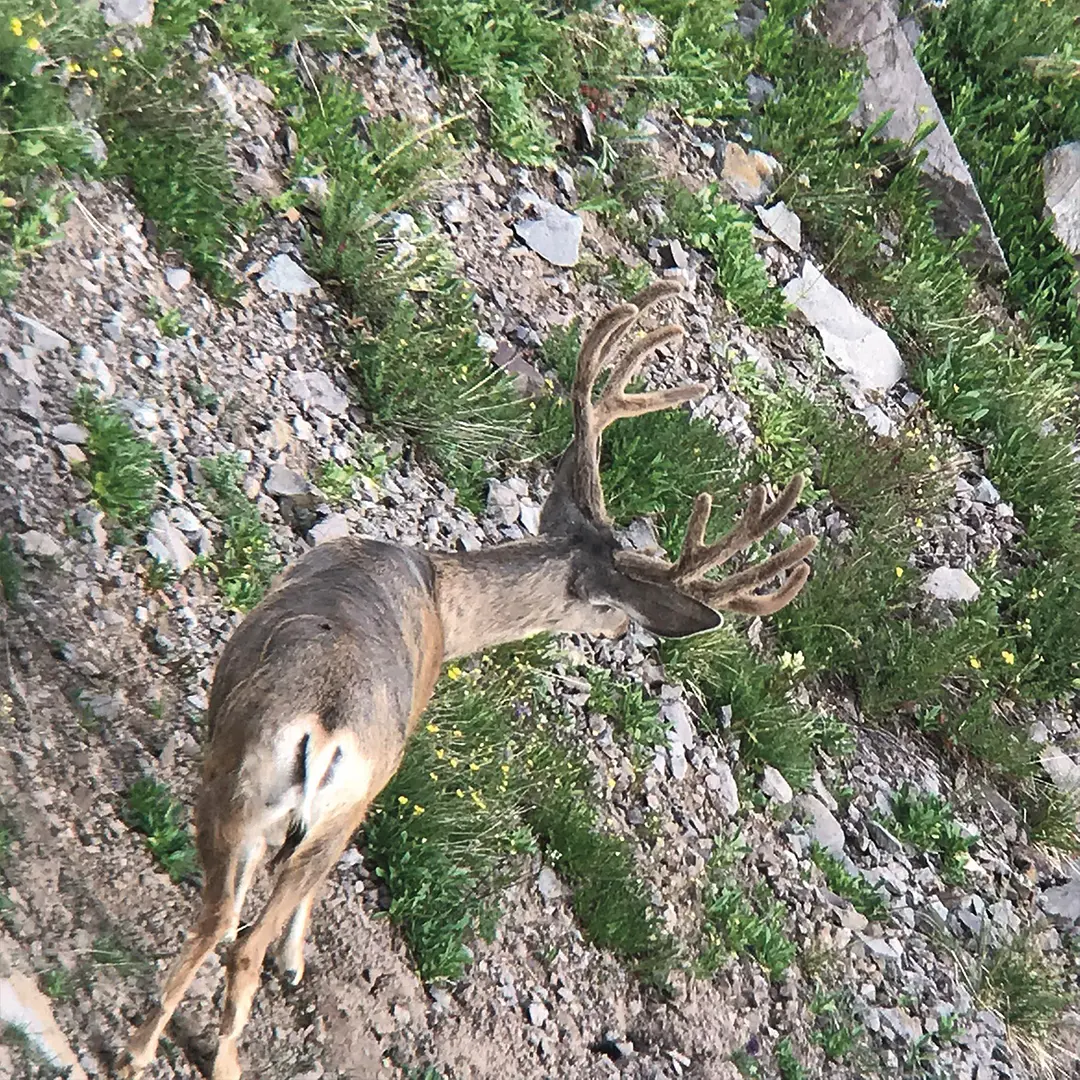
The buck was quickly on his feet and moving. I nocked a second arrow and drew. He was quartering away, still under 20 yards, but not stopping. I instinctively took aim and released the second arrow. I watched in what seemed like slow motion as the arrow sunk behind his last rib and buried to the feathers. He ran out below me and crashed into a sea of willows. I marked the location and watched intently. Seeing no movement, I backtracked to my pack, and when I reached it, he was up again.
I scrambled to get my binoculars and followed him as he stumbled through the willows. I knew the hit was vital and was determined not to lose him in the thick brush. He finally stopped and tipped over. I could only see the tip of an antler on the ground in a small window through the willows and decided to wait before approaching. I got out my tripod and spotting scope, fixing it on his location. Worried that I may bump him before he expired, I forced myself to wait another half hour, intently watching that antler tip through the spotter. It didn’t move.
Success at Last
I donned my pack and boots and made the descent into the basin, keeping a close eye on my markers for his location, but when I got down there I was more than confused. Finally, I was able to line up my markers from where I saw him last in relation to where I was sitting, and there he was, dead in a small hole in the willows. I thanked the lord, took some photos, quartered the buck, and loaded it into my pack. It was heavy, but I was determined to make it to camp in one trip. It was all downhill after all.
I arrived at camp just before dark, a grin on my face from ear to ear, and the look on Jonny’s face when he saw the velvet antlers on my back was priceless. The big storm I had worried about was rolling in but we didn’t care. I sat by the fire with Jonny and caped out my buck in my rain gear, detailing to him the day’s events. I had accomplished a long-time dream of taking a mule deer buck with my stick bow in the high country, and a little rain only added to the experience.
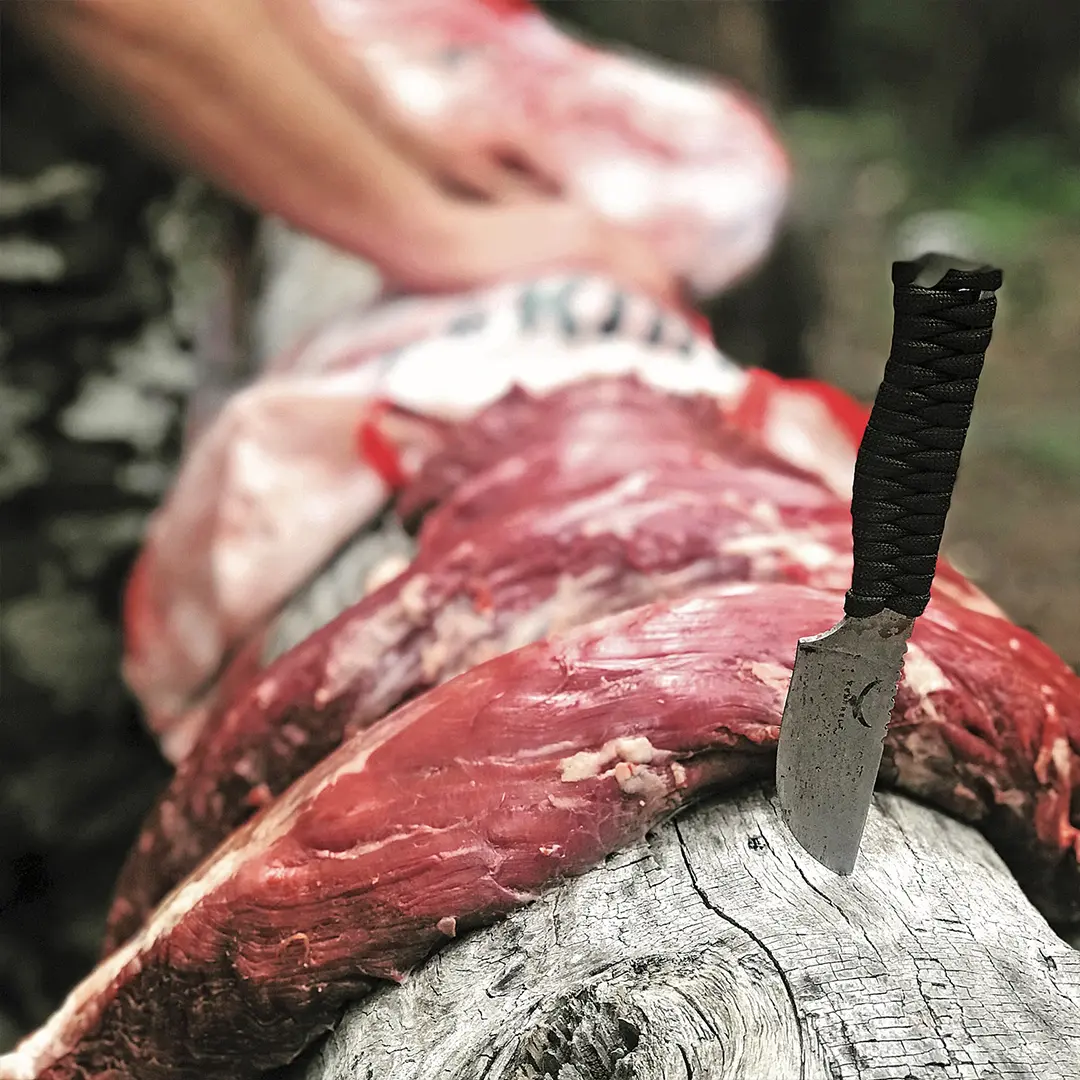
I deboned the meat, hung it in bags under a makeshift lean-to to keep it out of the rain, and went to sleep. In the morning Jonny graciously carried half the meat. Once we reached the highway, we were flagged down by two hunters we met at plan A. They noticed antlers in the bed of the truck, and we pulled over to share stories. I was beaming with pride as I told them how it all unfolded. Jonny and I made it to town in time for that hard-earned cheeseburger.
Hunting has taught me to seek and embrace challenges. Whether that challenge is a more primitive weapon, a tougher style of hunting, or taking the risk to invest in an out-of-state hunt, I have learned that the effort put forth only makes the whole experience more rewarding, and I can’t wait for the next adventure.
Luke Griffiths, CO 2019

